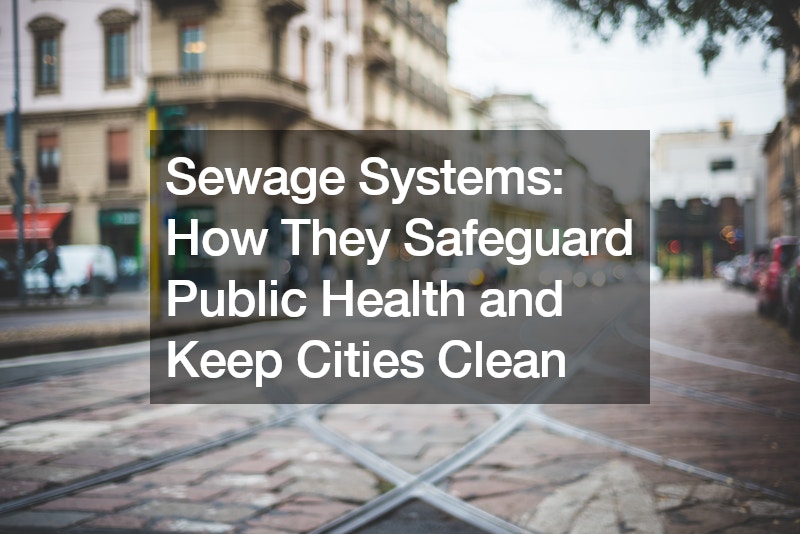In the bustling arteries of urban landscapes, beneath the concrete pavements and bustling streets, lies an intricate network of sewage systems. These systems are the silent guardians of public health and cleanliness, tirelessly working to ensure the safe disposal of waste and the prevention of disease spread. In this article, we’ll delve into the essential role of sewage systems in safeguarding public health and maintaining the cleanliness of our cities.
The Importance of Sewage Systems
Sewage systems are not merely conduits for waste disposal; they are indispensable components of modern civilization. Without them, urban areas would be susceptible to the rampant spread of diseases, contamination of water sources, and environmental degradation.
By efficiently collecting and transporting wastewater away from populated areas, sewage systems mitigate the risk of sanitation-related illnesses and uphold public health standards.
Urban Sanitation and Disease Prevention
One of the primary functions of sewage systems is to prevent the proliferation of disease-causing pathogens. Human waste contains a myriad of harmful bacteria, viruses, and parasites that pose significant health risks if left untreated. Sewage systems serve as the first line of defense against these pathogens, transporting waste to treatment facilities where it undergoes purification processes before being safely discharged into the environment.
Maintaining Clean Water Sources
Another critical role of sewage systems is to protect clean water sources from contamination. Untreated wastewater can contain pollutants and toxins that have detrimental effects on aquatic ecosystems and human health. By diverting sewage away from rivers, lakes, and groundwater reservoirs, sewage systems help preserve the integrity of these vital water sources, ensuring they remain safe for drinking, recreation, and ecological balance.
Challenges and Innovations
Despite their importance, sewage systems face numerous challenges, including aging infrastructure, capacity limitations, and the threat of pollution. To address these challenges, engineers and environmental scientists continuously innovate new technologies and strategies to enhance the efficiency and sustainability of sewage systems. One such innovation is the use of “pipeline pigs,” robotic devices that traverse sewage pipelines to inspect, clean, and maintain them. These high-tech tools play a crucial role in ensuring the integrity and functionality of sewage networks, reducing the risk of blockages, leaks, and other infrastructure failures.
Environmental Impact and Sustainability
Sewage systems also have significant environmental implications, affecting water quality, biodiversity, and ecosystem health. Effluent discharged from sewage treatment plants can contain nutrients, pharmaceuticals, and chemicals that may disrupt natural ecosystems and harm aquatic life. To mitigate these impacts, wastewater treatment facilities employ advanced treatment methods to remove contaminants and minimize environmental harm. Additionally, efforts are underway to promote sustainable wastewater management practices, such as water reuse, energy recovery, and nutrient recycling, to minimize the ecological footprint of sewage systems.
The Role of Public Education
Public education plays a crucial role in promoting responsible sewage management practices and fostering environmental stewardship. By raising awareness about the importance of proper waste disposal and the consequences of pollution, communities can empower individuals to make informed choices that protect water quality and public health. Public education campaigns can highlight simple actions that individuals can take, such as avoiding flushing non-biodegradable items down the toilet, reducing household chemical usage, and properly disposing of hazardous waste.
Moreover, education initiatives can emphasize the benefits of using environmentally-friendly products and adopting water-saving habits to reduce the burden on sewage systems and conserve resources. By engaging citizens in conversations about sewage management and environmental sustainability, communities can foster a sense of collective responsibility and encourage positive behavior change. Ultimately, public education efforts can help build a culture of environmental awareness and action, contributing to the long-term health and resilience of sewage systems and the ecosystems they support.
Emerging Technologies in Wastewater Treatment
Advancements in wastewater treatment technologies hold promise for improving the efficiency, effectiveness, and sustainability of sewage systems. From membrane filtration to ultraviolet disinfection, these innovative solutions offer new approaches to removing contaminants and producing high-quality effluent. Membrane filtration, for example, utilizes semi-permeable membranes to separate solids, pathogens, and pollutants from wastewater, resulting in cleaner effluent and reduced environmental impact.
Similarly, ultraviolet disinfection systems use UV light to destroy bacteria, viruses, and other microorganisms in wastewater, providing a chemical-free alternative to traditional disinfection methods. Advanced oxidation processes, such as ozonation and photocatalysis, harness the power of reactive oxygen species to degrade organic pollutants and neutralize harmful compounds, further enhancing treatment efficiency.
Conclusion
In conclusion, sewage systems are indispensable components of modern society, playing a vital role in safeguarding public health and maintaining the cleanliness of our cities. By efficiently collecting, treating, and disposing of wastewater, sewage systems mitigate the spread of disease, protect clean water sources, and preserve environmental quality. However, as urban populations continue to grow and environmental pressures mount, the importance of sustainable sewage management practices becomes increasingly apparent. Through innovation, collaboration, and responsible stewardship, we can ensure that sewage systems remain effective, efficient, and environmentally sustainable for generations to come.
.





